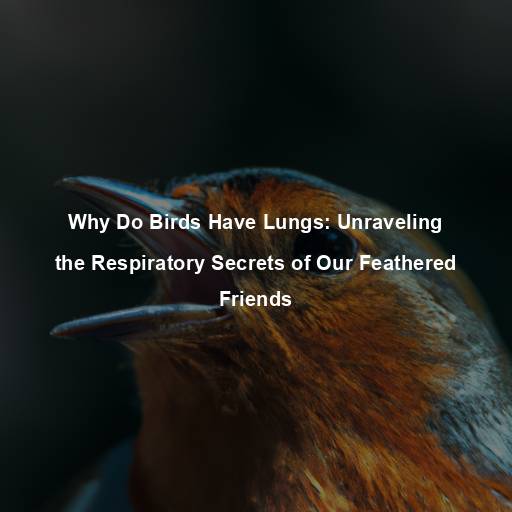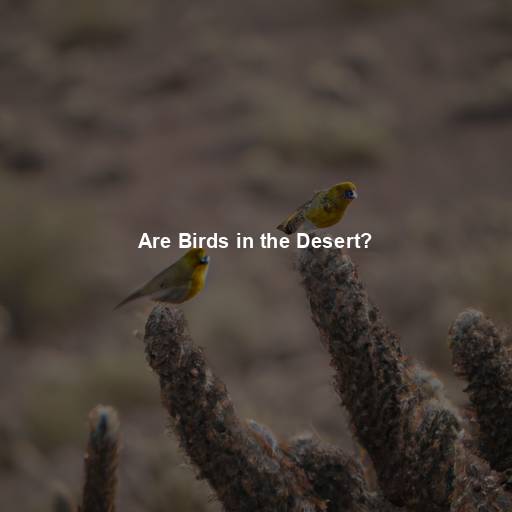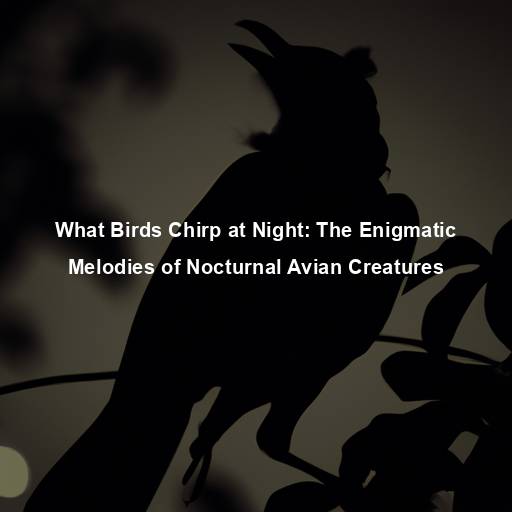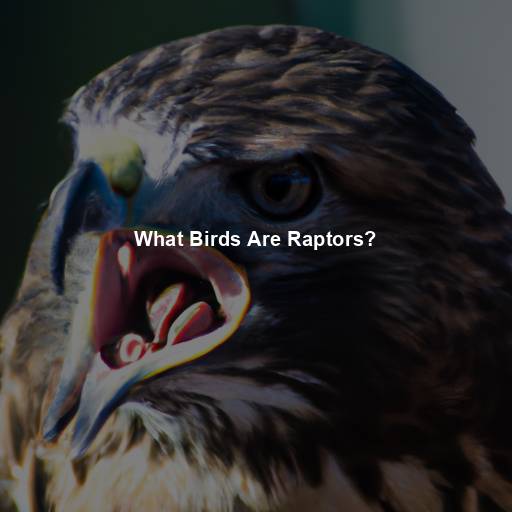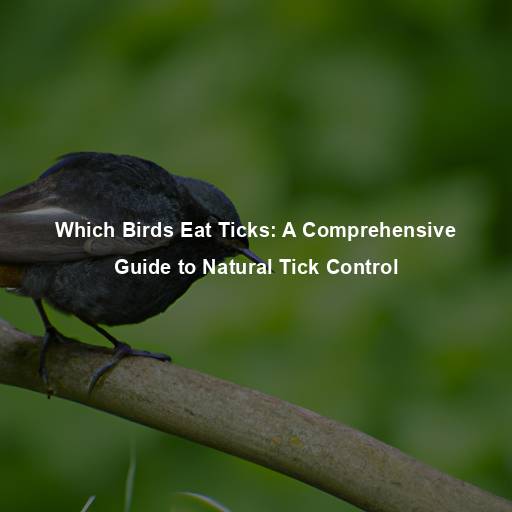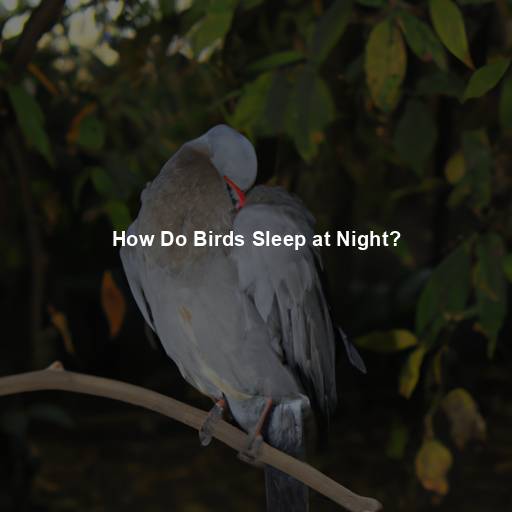Why Do Birds Have Lungs: Unraveling the Respiratory Secrets of Our Feathered Friends
Last Updated on July 17, 2023 by Evan
Contents
- 1 The Marvels of Avian Respiration
- 1.1 The Essence of Breathing: The Role of Lungs in Birds
- 1.2 Air Sacs: The Wings of Respiration
- 1.3 Unidirectional Airflow: The Bird’s Respiratory Symphony
- 1.4 The Magic of Parabronchi: Oxygen Exchange at its Finest
- 1.5 Avian Respiration in Flight: A Delicate Balancing Act
- 1.6 The Oxygen Mystery: The Avian Hemoglobin Connection
- 1.7 Adaptations for High Altitude Living: Conquering Thin Air
- 1.8 The Resilience of Avian Respiration: Overcoming Environmental Challenges
- 1.9 Surviving Extreme Temperatures: The Art of Thermoregulation
- 1.10 Adapting to High Altitudes: The Thin Air Challenge
- 1.11 Air Pollution: A Threat to Avian Respiratory Health
- 1.12 Avian Respiratory Infections: A Silent Threat
- 1.13 Flightless Birds: A Different Take on Respiration
- 1.14 The Evolutionary Puzzle: Tracing the Origins of Avian Respiration
- 1.15 Conservation Implications: Protecting Avian Respiratory Diversity
- 1.16 Wings of Endurance: Oxygen Storage in Flight Muscles
- 1.17 The Power of Resilience: Coping with Oxygen Debt
- 1.18 Aerodynamic Efficiency: Streamlining the Respiratory System
- 1.19 The Oxygen Exchange Puzzle: The Role of Crosscurrents
- 1.20 Endurance Flyers: Mastery of Long-Distance Migration
- 1.21 The Vocal Virtuosos: Respiration and Birdsong
- 1.22 Avian Respiration in Diving Birds: A Subaquatic Adventure
- 1.23 Future Frontiers: Unraveling Unexplored Avian Respiratory Mysteries
- 2 FAQs – Why do birds have lungs?
- 2.1 Why do birds have lungs?
- 2.2 How do bird lungs function differently from human lungs?
- 2.3 Can birds breathe underwater?
- 2.4 Do birds breathe in the same way as humans?
- 2.5 Can birds fly higher because of their lungs?
- 2.6 Do all birds have the same lung capacity?
- 2.7 Are there any other functions of bird lungs?
- 2.8 Can birds get respiratory diseases?
The Marvels of Avian Respiration
Birds, with their enchanting melodies and graceful flights, have captivated our hearts for centuries. But have you ever wondered how these fascinating creatures breathe? While we humans rely on our lungs for respiration, birds possess a unique respiratory system that sets them apart from other animals. In this article, we will embark on a journey to unravel the secrets of avian respiration, exploring the remarkable adaptations that enable birds to thrive in the skies.
The Essence of Breathing: The Role of Lungs in Birds
Just like mammals, birds also possess lungs as their primary respiratory organs. However, the structure and functionality of avian lungs differ significantly from those of mammals. While mammalian lungs are relatively static, avian lungs are more dynamic and efficient. This allows birds to extract a greater amount of oxygen from the air, enabling them to sustain their high metabolic rates during flight.
Air Sacs: The Wings of Respiration
One of the key differentiators in avian respiration is the presence of air sacs. These thin, membranous structures are connected to the lungs and extend throughout the bird’s body, infiltrating various organs. Air sacs play a vital role in the respiratory process, acting as reservoirs that facilitate the unidirectional flow of air through the respiratory system.
Unidirectional Airflow: The Bird’s Respiratory Symphony
When it comes to breathing, birds have a fascinating trick up their feathers. Unlike us mere humans who rely on tidal breathing, these feathered creatures have mastered the art of unidirectional airflow. This ingenious system ensures a constant stream of fresh air to their lungs, giving them a boost in oxygen uptake. Thanks to their nifty air sacs that work like little bellows, the air flows in only one direction, making every breath a breath of efficiency and optimizing their gas exchange process.
The Magic of Parabronchi: Oxygen Exchange at its Finest
Within the lungs of birds, an intricate network of tiny tubes called parabronchi facilitates the exchange of oxygen and carbon dioxide. These parabronchi, unlike the bronchioles found in mammalian lungs, are arranged in a parallel fashion, allowing for a constant flow of air through them. This unique arrangement, combined with the unidirectional airflow, maximizes the efficiency of gas exchange and ensures birds can maintain their high metabolic demands.
Avian Respiration in Flight: A Delicate Balancing Act
Flying is an awe-inspiring feat that demands extraordinary stamina. In order to keep their wings beating and effortlessly glide through the sky, birds have developed intricate respiratory mechanisms. One of these adaptations is the phenomenon of “cyclic respiration,” a captivating strategy where birds rhythmically switch between intense oxygen intake and muted oxygen usage, enabling them to preserve precious energy during their ambitious journeys. These avian marvels continue to intrigue scientists and spark curiosity about the boundless wonders of the natural world.
The Oxygen Mystery: The Avian Hemoglobin Connection
To further optimize their respiratory efficiency, birds possess a unique type of hemoglobin in their blood. Avian hemoglobin has a higher affinity for oxygen, allowing it to bind more readily and efficiently to oxygen molecules. This specialized hemoglobin enables birds to extract a greater amount of oxygen from the air, compensating for the lower oxygen levels often found at high altitudes.
Adaptations for High Altitude Living: Conquering Thin Air
Some bird species have mastered the art of soaring through the skies at high altitudes, where oxygen levels are significantly lower. To survive in these extreme conditions, birds have developed additional respiratory adaptations. They have larger lungs relative to their body size, enabling them to take in more air and extract an adequate amount of oxygen. Additionally, their muscles and organs receive a rich blood supply, ensuring sufficient oxygen delivery to sustain flight at high altitudes.
The Resilience of Avian Respiration: Overcoming Environmental Challenges
Birds encounter a wide range of environmental challenges, from extreme temperatures to high altitudes and polluted air. However, their respiratory system has proven to be remarkably resilient, allowing them to adapt and thrive in diverse habitats. Their efficient lungs, unidirectional airflow, and specialized hemoglobin all contribute to their ability to overcome these challenges and maintain their remarkable aerial lifestyle.
Navigating the vast expanse of the sky is no small feat, and yet birds conquer this extraordinary challenge with their awe-inspiring respiratory system. The intricate network of air sacs and unidirectional airflow, combined with the remarkable structure of their lungs, allows these magnificent creatures to defy gravity and gracefully glide through the heavens. As we delve deeper into the study of avian respiration, we are left in awe of the sheer complexity and adaptability that enable birds to conquer the ever-changing elements. Let us take a moment to ponder the resilience of these feathered wonders and embrace the perplexity that nature so beautifully presents.
Surviving Extreme Temperatures: The Art of Thermoregulation
Birds are exposed to a wide range of temperatures, from scorching heat to freezing cold. To maintain their body temperature within a narrow range, birds employ a remarkable thermoregulation mechanism. Unlike mammals, which rely on sweat glands to cool down, birds dissipate heat through their respiratory system. By panting or gular fluttering (rapid throat movements), birds increase their respiratory rate, facilitating heat loss through evaporation.
Adapting to High Altitudes: The Thin Air Challenge
At high altitudes, where the air is thin and oxygen levels are low, birds face an additional challenge. To compensate for the decreased oxygen availability, birds have developed various adaptations. One such adaptation is an increased production of red blood cells, which enhances their oxygen-carrying capacity. Additionally, birds utilize a more efficient respiratory system, extracting a greater amount of oxygen from each breath.
Air Pollution: A Threat to Avian Respiratory Health
In today’s fast-paced and ever-changing society, it is no secret that our winged companions face a perplexing conundrum: air pollution. Nestled in urban jungles or perched near industrial giants, these majestic creatures find themselves in the midst of a burst of harmful pollutants – particulate matter and toxic gases. As we strive to be guardians of our environment, it becomes imperative for us to tackle this issue head-on, safeguarding the delicate respiratory health of our avian allies, lest their ability to soar freely and thrive becomes a puzzling challenge.
Avian Respiratory Infections: A Silent Threat
Birds, like us, can also fall prey to respiratory infections. One notorious culprit is avian influenza, a viral infection that targets our avian friends’ respiratory systems. This malicious illness poses a grave threat to birds, whether they reside in human-care or roam freely in the wild. Though the chances of avian influenza transmitting to humans are slim, it’s not entirely out of the question.
Flightless Birds: A Different Take on Respiration
While most birds are expert fliers, there are some species that have evolved to be flightless. Flightless birds, such as ostriches and penguins, have unique respiratory adaptations suited to their terrestrial or aquatic lifestyles. Ostriches, for example, have relatively larger lungs compared to their body size, enabling them to run at high speeds on land. Penguins, on the other hand, have specialized air sacs that help them control buoyancy while diving underwater.
The Evolutionary Puzzle: Tracing the Origins of Avian Respiration
The evolution of avian respiration is a fascinating puzzle that scientists continue to unravel. The transition from reptilian ancestors to modern birds involved significant modifications to the respiratory system. Fossils of ancient birds provide valuable insights into the gradual development of avian respiration. Studying these fossils, researchers have discovered intermediate forms that bridge the gap between reptilian lungs and the highly efficient avian respiratory system we see today.
Conservation Implications: Protecting Avian Respiratory Diversity
Have you ever wondered how birds breathe? It’s not just a fun fact, but a vital piece of knowledge that can help us protect these magnificent creatures. By delving into the intricacies of avian respiration, scientists are uncovering valuable information that can guide conservation efforts. Understanding how birds adapt to their environment can help us develop targeted strategies to ensure their survival in a constantly evolving world.
The fascinating world of avian respiration never fails to astonish. Through an intricate array of specialized mechanisms, birds have perfected their respiratory systems to withstand various challenges. From adapting to radical temperature changes to conquering high altitudes, these creatures continuously showcase their incredible resilience and adaptability. Let us embark on a journey deeper into the secrets of avian respiration, as we strive to protect their habitats and marvel at the majestic beauty of birds in all their feathered glory.
Wings of Endurance: Oxygen Storage in Flight Muscles
The celestial act of flight is a marvel that bewitches us all, but have you ever pondered the enigmatic secret behind avian maneuverability? Enter birds, these extraordinary creatures have unraveled the perplexing code of efficient flight. Through the art of evolution, they have devised a remarkable solution: oxygen storage within their mighty winged engines. Myoglobin, a wondrous protein, is their ticket to endurance as it stores oxygen and dispenses it strategically during moments of heightened exertion.
The Power of Resilience: Coping with Oxygen Debt
Flying can be an exhilarating experience for birds, but it’s not always smooth sailing. In those moments of intense flight, birds may find themselves in the perplexing predicament of oxygen debt, a situation where their need for oxygen surpasses its availability. However, these remarkable creatures have evolved an awe-inspiring ability to bounce back. By ramping up their breathing and heart rates, birds are able to deliver a burst of oxygen, rejuvenating their oxygen-depleted tissues and allowing them to navigate the skies with agility and adaptability.
Aerodynamic Efficiency: Streamlining the Respiratory System
Birds, marvels of nature, possess an intricate respiratory system that transcends mere lungs and air sacs. Every aspect of their unique anatomy plays a pivotal role in their ability to conquer the skies. Remarkably, the absence of a diaphragm enables their internal organs to stay suspended higher within their bodies, paving the way for expansive air sacs and a lighter physique. This ingenious adaptation culminates in a streamlined form that effortlessly slices through the air, amplifying the bird’s flight capabilities to unparalleled heights.
The Oxygen Exchange Puzzle: The Role of Crosscurrents
Deep within the intricate realm of avian lungs, a fascinating phenomenon known as crosscurrent exchange unfolds. A captivating departure from the age-old principles witnessed in fish gills, this mechanism orchestrates a dance of oxygen-rich and oxygen-poor airflows within the labyrinthine parabronchi. By navigating this bewildering maze, birds achieve unparalleled respiratory efficiency, enabling an optimal balance between oxygen absorption and carbon dioxide liberation – an exquisite adaptation tailored to the soaring demands of their airborne existence.
Endurance Flyers: Mastery of Long-Distance Migration
It’s truly remarkable how some bird species embark on epic migration journeys, journeying countless miles to find their perfect breeding or wintering spots. What’s even more astounding is how they manage to sustain themselves through these arduous flights. These feathered adventurers have evolved remarkable respiratory adaptations that support their endurance, enabling them to keep flying for prolonged periods without tiring out. By efficiently breathing in oxygen and employing energy-saving techniques like riding air currents, they’re able to conserve their energy stores and conquer vast distances.
The Vocal Virtuosos: Respiration and Birdsong
The enchanting melodies of birdsong have long fascinated us, revealing a captivating glimpse into the world of avian behavior. These intricate vocalizations serve a multitude of purposes, from wooing potential mates to defending precious territories. It is through the remarkable control they exert over their respiratory system that birds are able to produce such complex melodies. Nestled at the base of their trachea lies their secret weapon: the syrinx – a specialized vocal organ unique to birds.
Avian Respiration in Diving Birds: A Subaquatic Adventure
While most birds are associated with the skies, some species have adapted to an entirely different environment – the water. Diving birds, such as ducks and penguins, have evolved unique respiratory adaptations to thrive in aquatic habitats. When diving, these birds can close off their airways, preventing water from entering their lungs. They rely on oxygen stored in their blood and muscles to survive underwater, resurfacing periodically to replenish their oxygen supply.
Future Frontiers: Unraveling Unexplored Avian Respiratory Mysteries
Dive into the captivating world of avian respiration as scientists untangle the enigmatic secrets that have perplexed them for decades. With each new discovery, more mysteries unravel, propelling researchers on a tireless quest to unlock the mechanisms behind oxygen storage and release in the awe-inspiring flight muscles of birds. As they dig deeper into the genetic landscape, the intricate interplay between specific genes and avian respiratory adaptations unveils itself, shedding light on the intricate tapestry of life. Through the treacherous terrains of extreme environments, birds embark on a breath-taking challenge, and scientists strive to comprehend the respiratory hurdles they face.
In conclusion, the respiratory system of birds is a masterpiece of adaptation and efficiency, finely tuned to meet the demands of flight and survival in diverse habitats. From oxygen storage in flight muscles to streamlined respiratory structures, birds have evolved an array of remarkable respiratory adaptations. Exploring the intricacies of avian respiration not only deepens our appreciation for the wonders of nature but also sheds light on the fascinating interplay between form and function in the animal kingdom. Let us continue to marvel at the respiratory secrets of our feathered friends and nurture a deep respect for the remarkable adaptations that make birds soar above the rest.
FAQs – Why do birds have lungs?
Why do birds have lungs?
Birds have lungs in order to breathe and obtain oxygen for their bodies. Lungs play a crucial role in the process of respiration, allowing birds to take in oxygen from the air and release carbon dioxide. This allows them to carry out the necessary metabolic functions and maintain their energy levels.
How do bird lungs function differently from human lungs?
Bird lungs differ from human lungs in their structure and function. While humans have two lungs, birds have a unique system called the air sacs, which are connected to their lungs. These air sacs extend to various parts of the bird’s body, including the hollow bones. This allows for a continuous flow of air through the lungs, ensuring a more efficient exchange of gases, especially during high-energy activities like flying.
Can birds breathe underwater?
No, birds cannot breathe underwater. Although some birds are excellent swimmers, they rely on their lungs to extract oxygen from the air, not from water. Unlike marine mammals like dolphins and whales, birds have not evolved the ability to breathe underwater.
Do birds breathe in the same way as humans?
Did you know that birds have a secret breathing technique that puts humans to shame? Unlike us, birds have a unique system where air takes a detour through their posterior and anterior air sacs, making their respiratory process far more intricate. By utilizing this unidirectional airflow, birds are able to maximize oxygen exchange and efficiently rid their bodies of carbon dioxide. It’s no wonder they can fly with such grace and ease! So the next time you marvel at a bird in flight, remember, their mysterious breathing mechanism is what sets them apart from us mere humans.
Can birds fly higher because of their lungs?
The incredible capacity of birds to take flight is truly awe-inspiring. Their lungs, finely tuned by evolution, play a crucial role in sustaining their vigorous airborne adventures. Not only do they boast a remarkable respiratory system, but it is their one-of-a-kind cardiovascular system that steals the show, enabling them to reach majestic heights with unparalleled grace and agility. As birds soar through the skies, their bodies efficiently distribute precious oxygen, fueling their boundless energy and filling us with wonder at the marvels of nature’s design.
Do all birds have the same lung capacity?
Have you ever wondered why some birds seem to have endless energy while others struggle to catch their breath? Well, the secret lies in their remarkable lung capacity. It turns out that birds, just like humans, come in all shapes and sizes, and their lung capacity varies greatly based on a multitude of factors. From the mighty wings of soaring eagles to the tireless migrations of songbirds, these adaptations have allowed them to conquer the skies in their own unique way. So, next time you spot a bird in flight, marvel at the burst of life soaring through its lungs, and ponder the perplexity of nature’s design.
Are there any other functions of bird lungs?
Apart from respiration, bird lungs serve some additional purposes. In birds, these organs are also involved in vocalization, producing specific sounds by regulating the airflow through the vocal cords or syrinx. Additionally, bird lungs provide support for their respiratory system by minimizing the risk of collapsing airways during rapid changes in air pressure, which frequently occurs during flight.
Can birds get respiratory diseases?
Yes, birds can suffer from respiratory diseases just like any other animal. They are susceptible to infections, lung parasites, and environmental pollutants that can affect their respiratory health. Common respiratory diseases in birds include avian influenza, aspergillosis, and psittacosis. Proper care, hygiene, and regular veterinary check-ups are essential to maintain the respiratory well-being of pet birds and prevent the spread of diseases in wild populations.

